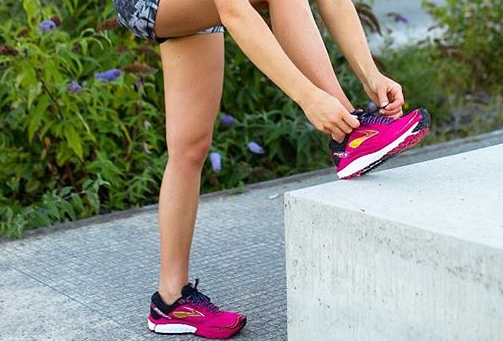Sensorimotor neuropathy of the feet maybe one reason most runners get injured, and keep getting injured. When we wear cushioned footwear during running, the nerves in the feet have a less functional role at controlling impact moderating behavior, causing runners to not only strike the ground on the heel, but to do so with more impact as compared with running barefoot where the nerves in the feet are better able to convey spatial, pressure and other forms of sensory information to the brain.
Running barefoot provides the brain with better ‘as-it-happens’ sensory information which prompts quicker withdrawal reflexes in the leg and feet, preventing a mis-identification in foot strike, thereby encouraging a forefoot strike vs a heel strike and thus less sudden loading on the body.

Cushioned Running Shoes Cause Sensorimotor Neuropathy
I think many experts are beginning to settle on the fact the brain has difficulties in conceiving the proper foot strike when running in shoes that are too thickly cushioned and misdirects the foot to heel strike. Protective footwear blocks cutaneous and vibratory plantar cues, causing sensory deficits in the foot/ankle complex. This is an example of motor and sensory neuropathy symptoms.
- Motor and sensory neuropathy are characterized by deficiencies in proprioception resulting in a loss of perceived vibratory and cutaneous stimuli on the bottoms of the feet, a loss of joint position and movement detection, and reduced acuity of movement perception.
According to Deursen and Simoneau (1999), protective footwear is commonly prescribed to unload the foot in individuals with motor and sensory neuropathies, however there does not appear to be any supporting evidence suggesting that shoe cushioning is useful. Contrary to naive intuition, protective footwear is the origin of the problem.
To Be Biomechanically Normal, You Need Good Proprioception
Proprioception is vital in running because the sensory receptors in the feet have strong connections with multiple specialized anatomical pathways devoted to biomechanics.
More importantly, proprioception has a heavy evolutionary significance because many nerve fibers go back and forth between the feet and the old pathway of the brain, the brain-stem (the stalk that emerges from below the brain and continues as the spinal cord). This pathway helps you reflexively orient and move your lower extremity without thinking about it.
Good proprioception depends on the source of the signal from the plantar surface whereby barefoot or pure minimalist shod conditions are associated with enhanced plantar cutaneous and vibratory sensations, allowing a runner to create a meaningful perception of their environment.
In contrast, runners who wear protective footwear run blindly, in a sense. Because cushioned materials diminish cutaneous and vibratory sensations, movement perception is significantly degraded.
A compelling example of this comes from a study by Robbins et al. which confirmed that protective footwear caused a loss of cutaneous, vibratory and pressure sensations by reduced proprioceptive sensibility. The result, proprioception dysfunction which is synonymous to motor and sensory neuropathy. The consequence, a runner will exhibit staggered and rushed movements, compromised postural stability with a greater chance of tripping and falling, and inappropriate footfalls.
And lastly, given that proprioception is diminished in protective footwear, the researchers argued that orthotics would be an extra challenge for the maintenance of balance. Orthotics is just another added layer that blinds the feet.
The Take Home Message
Proprioception is as old as humans are which is why we run with great difficulty in the absence of it. Because proprioception is heavily interconnected with the brain-stem, blocking it undermines health on a wide scale.
Protective footwear is the main external trigger for reducing proprioception, thereby contributing to motor and sensory neuropathy and influencing the tendency to injure during running. After all, the high injury rate in habitual shod populations indicates that there are no upsides to protective footwear.
Finally, sudden radical transformations is the hallmark of barefoot or pure minimalist shod conditions. Previous work on running-related injuries demonstrated that barefoot or pure minimalist activity are optimal intervention strategies, especially for fixing posture deficits. Because the proprioceptors are more stimulated under these conditions, they are more likely to bring immediate relief to runners who struggle with movement impairments.
To learn more, you’ll love my YouTube video where I discuss, in more detail, the influence of cushioned running shoes on causing poor quality, sensory processing in the foot.
More From Run Forefoot:
- Spark Knee Injury Recovery without a Knee Brace
- Applying Pose Running to Forefoot Running
- Back Pain When Running
- Best Wake-Me-Up Coffees for Runners
- Best Barefoot Running Blogs
References:
Deursen RM and Simoneau GG. Foot and ankle sensory neuropathy, proprioception, and postural stability. J Orthop Sports Phys Ther, 1999;29(12):718-726.
Gandevia SC and Burke D. Does the central nervous system depend on kinesthetic information to control natural limb movements. Behav Brain Sci, 1992;15:6141-632.
Bretta Riches
BSc Neurobiology; MSc Biomechanics candidate, ultra minimalist runner & founder of RunForefoot. I was a heel striker, always injured. I was inspired by the great Tirunesh Dibaba to try forefoot running. Now, I'm injury free. This is why I launched Run Forefoot, to advocate the health & performance benefits of forefoot running and to raise awareness on the dangers of heel striking, because the world needs to know.
Latest posts by Bretta Riches (see all)
- Can You Run In Barefoot Shoes? Yes, But DON’T Heel Strike! - 21/07/2024
- Why Cushioned Running Shoes Are Really Bad for Your Feet - 19/07/2024
- Do Cushioned Running Shoes Cause Injuries? - 17/07/2024

Leave a Reply